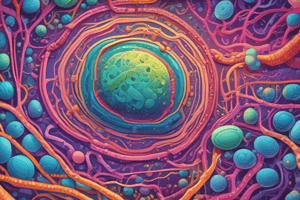Podcast
Questions and Answers
Which of the following ions has a higher concentration inside the cell compared to outside?
Which of the following ions has a higher concentration inside the cell compared to outside?
- K+ (correct)
- Cl-
- Ca++
- Na+
What percentage of cytosol is composed of oxygen?
What percentage of cytosol is composed of oxygen?
- 10%
- 20%
- 3%
- 62% (correct)
Which element is considered crucial for living systems and present in cytosol?
Which element is considered crucial for living systems and present in cytosol?
- Copper
- Chlorine
- Zinc
- Carbon (correct)
Which of the following is NOT classified as a trace element found in cytosol?
Which of the following is NOT classified as a trace element found in cytosol?
What is one of the main functions of ions in cytosol?
What is one of the main functions of ions in cytosol?
Which of the following essential elements contributes to 0.14% of the cytosol's composition?
Which of the following essential elements contributes to 0.14% of the cytosol's composition?
Which buffering system is associated with cytosol?
Which buffering system is associated with cytosol?
Which of the following elements is NOT essential for life?
Which of the following elements is NOT essential for life?
Which ionic concentration is higher outside the cell?
Which ionic concentration is higher outside the cell?
What physical characteristic describes cytosol?
What physical characteristic describes cytosol?
Flashcards are hidden until you start studying
Study Notes
Prokaryotic Cells
- Stromatolites are colonies of ancient cyanobacteria found in Western Australia.
- Prokaryotic cells lack a true nucleus and are generally smaller than eukaryotic cells.
- Structure includes plasma membrane, cytoplasm, nucleoid, ribosomes, and plasmids.
Plasma Membrane
- Thickness ranges from 6-8 nm, dynamic, covers bacterial protoplasm.
- Composed of a lipid bilayer with embedded proteins, following the fluid-mosaic model.
- Associated with DNA, with membrane intrusions such as mesosomes and chromatophores.
Mesosomes
- Infoldings of the plasma membrane, increasing surface area in contact with the cytoplasm.
- Present in Gram-positive and some Gram-negative bacteria.
- Involved in cell division through cross-wall septum formation.
Chromatophores
- Similar structures to mesosomes but differ in shape; can appear as vesicles or tubes.
- Contain photosynthetic pigments, aiding in energy production.
Cytoplasm
- The ground substance where metabolic activities occur, containing water, proteins, lipids, and carbohydrates.
- Includes a less dense area for reserve material and dense areas known as inclusion bodies (e.g., volutin granules, hydrogen sulfide droplets).
Nucleoid
- Contains the bacterial chromosome: a single, circular, double-stranded DNA.
- Not separated from cytoplasm by a membrane; concentrated in a specific cytoplasmic region.
- DNA attaches to the plasma membrane at one site, lacking histone proteins but containing heat-stable proteins.
Ribosomes
- Size: 25 nm; composed of rRNA and proteins, functioning as the site for protein synthesis.
- Bacterial ribosomes are classified as 70s; exist as free or attached to the plasma membrane.
Plasmids
- Extrachromosomal, small circular DNA molecules, not present in all bacteria.
- Can carry genes for antibiotic resistance (R factors) or fertility factors (F factors) for conjugation.
Cell Wall
- Provides rigid structural support; differs from plant cell walls by composition.
- Essential for maintaining cell shape and providing mechanical protection.
Capsule
- Some bacteria have an additional layer of slime or gel surrounding their cell wall.
- Functions in protection against phagocytosis and facilitating ion and water transport.
Flagella
- Motile bacteria possess flagella, which are 15-20 nm in diameter and can be up to 20 µM long.
- Made from flagellin, these appendages allow bacteria to move by rotating like a propeller.
Fimbriae and Pili
- Found mostly in Gram-negative bacteria; non-motile, adhesive structures.
- Pili are involved in conjugation, facilitating genetic exchange between bacteria.
Spinae
- Rigid, tubular appendages in some Gram-positive bacteria, aiding survival in harsh conditions.
Reproduction in Prokaryotes
- Primarily through binary fission; conjugation allows for genetic exchange between bacteria.
Eukaryotic Cells
- Compared to prokaryotes, eukaryotic cells have a well-developed nucleus and multiple membrane-bound organelles.
- Larger in size, with a complex organization that includes an endoplasmic reticulum.
Protoplasm and Cytosol
- Protoplasm consists of living and non-living substances essential for cellular function.
- Cytosol refers to the fluid portion of cytoplasm; it's translucent, viscous, and gelatinous.
Ions and Trace Elements
- Cytosol contains approximately 46 of the 92 naturally occurring elements, with 24 being essential for life.
- Six essential elements include carbon, hydrogen, nitrogen, oxygen, phosphorus, and sulfur.
- Trace elements are vital for metabolism, assisting in various biological functions.
Buffering Systems
- Buffering systems maintain pH balance in cells; blood uses H2PO4- while cytosol uses HPO4-.
- Ions such as K+ and Mg++ are more concentrated inside cells, while Na+ and Cl- are more concentrated outside.
Studying That Suits You
Use AI to generate personalized quizzes and flashcards to suit your learning preferences.




